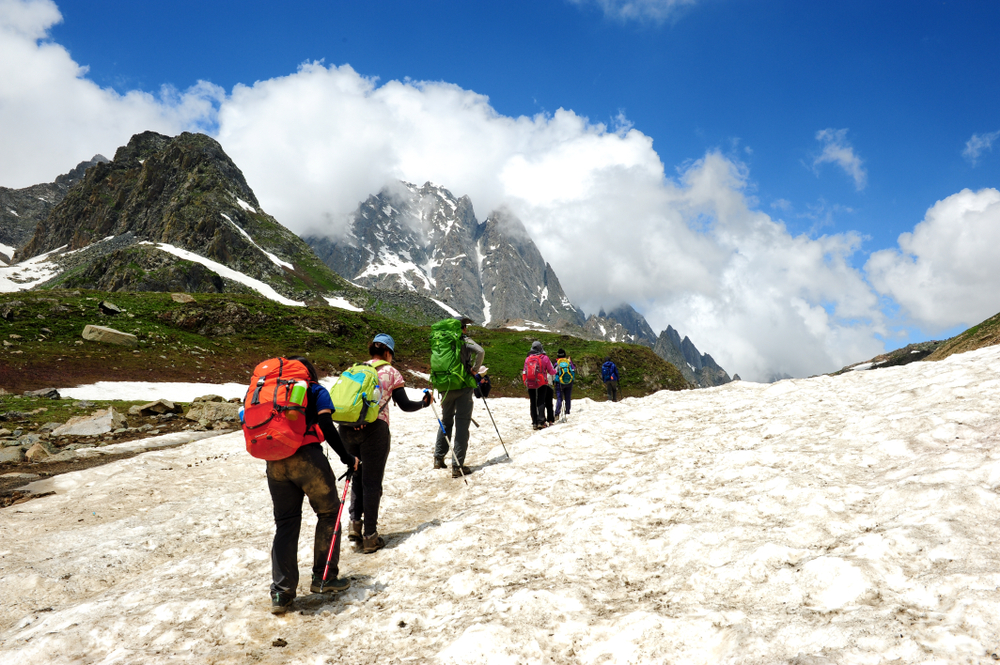
1. Physical Preparation and Fitness
Embarking on the Kashmir Great Lakes Trek requires a solid foundation of physical fitness. I began my preparation months in advance, focusing on cardiovascular exercises like running and cycling to build endurance. Strength training, particularly targeting the legs and core, was crucial for navigating the varied terrains. Additionally, I incorporated flexibility exercises to enhance agility and reduce the risk of injuries.
To simulate trekking conditions, I practiced hiking with a loaded backpack on different terrains. This not only helped in building stamina but also in getting accustomed to carrying weight over long distances. Regular stretching routines became a part of my daily regimen, ensuring my muscles remained supple and prepared for the trek’s challenges.
2. Essential Gear and Packing List
Packing efficiently was vital for the trek. I ensured to include sturdy trekking shoes with good grip, a 50-60 liter backpack with a rain cover, layered clothing including thermal wear, fleece jackets, and a waterproof outer layer. Trekking poles provided stability, and a headlamp with extra batteries was essential for early morning starts and late evening activities.
Organizing items in waterproof bags kept them dry and accessible. I also packed essential toiletries, including biodegradable soap, toothbrush, toothpaste, and quick-dry towels. Carrying a multi-tool knife and duct tape proved handy for unexpected situations. Ensuring all items were lightweight and multifunctional helped in maintaining a manageable backpack weight.
3. Best Time to Trek

I chose to trek between July and September, which is considered the optimal window. During this period, the trails are accessible, and the meadows are in full bloom, offering breathtaking vistas. The weather is relatively stable, with clear skies and moderate temperatures, making the trekking experience more enjoyable.
However, I remained prepared for sudden weather changes by carrying appropriate rain gear and warm clothing. This ensured comfort and safety throughout the trek. Planning the trek during this time also meant encountering fewer crowds, allowing for a more serene experience amidst nature.
4. Route and Itinerary Overview
The trek spanned over 7 days, starting from Sonamarg and concluding at Naranag. Each day presented unique challenges and scenic rewards, from alpine lakes to high mountain passes. Acclimatization was integral, and I ensured to pace myself to adapt to the altitude.
The journey included traversing through Nichnai Pass, Vishansar Lake, Gadsar Pass, and Gangbal Lake. Each location offered distinct landscapes, from lush meadows to rocky terrains. Proper planning and understanding of the daily itinerary helped in managing energy levels effectively.
5. Travel and Logistics
I flew into Srinagar and arranged for transportation to Sonamarg, the trek’s starting point. Post-trek, I returned to Srinagar from Naranag. Booking accommodations and transport in advance ensured a smooth experience.
Organising with regional travel companies made lodgings and transfers dependable. I also accounted for buffer days to accommodate any unforeseen delays, ensuring a stress-free travel experience. Having a flexible itinerary allowed me to explore local attractions in Srinagar before and after the trek.
6. Essential Documents and Permits
Carrying valid ID proof, such as an Aadhar card or passport, was mandatory. Additionally, obtaining the necessary trekking permits from the local authorities was crucial. Having multiple photocopies and digital backups of these documents proved helpful.
These documents were required at various army checkposts along the trek. Ensuring all paperwork was in order facilitated smooth passage and avoided any administrative hurdles during the journey. It’s advisable to keep these documents easily accessible in a waterproof pouch.
7. Acclimatization and Altitude Sickness
I stayed in Sonamarg for a day prior to the journey in order to reduce the chance of developing Acute Mountain Sickness (AMS). During the trek, I maintained a steady pace, stayed hydrated, and listened to my body’s signals. Recognizing symptoms like headaches or dizziness early allowed me to take necessary precautions.
I also avoided alcohol and caffeine, as they can exacerbate altitude-related issues. Consuming a high-carbohydrate diet and ensuring adequate rest each night further supported acclimatization efforts. Carrying medications like Diamox, after consulting a doctor, provided an added layer of safety.
8. Nutrition and Hydration
Maintaining energy levels was essential. Meals provided were nutritious, and I supplemented them with energy bars and dry fruits. Drinking ample water and using purification tablets ensured I stayed hydrated and avoided waterborne illnesses.
I also included electrolyte powders in my water to replenish salts lost through sweating. Regular snacking between meals helped in sustaining energy levels during long trekking hours. Avoiding heavy meals before strenuous climbs prevented discomfort and fatigue.
9. Navigational and Safety Tips
While the trail was generally well-defined, I carried offline GPS maps as a backup. Staying with the group, using trekking poles, and being cautious on challenging terrains enhanced safety. Being aware of weather changes and adjusting plans accordingly was also vital.
I also kept emergency contact numbers handy and informed someone about my daily itinerary. Having a simple first-aid kit and a whistle on hand guaranteed readiness for any unexpected circumstances. Regularly checking in with fellow trekkers fostered a supportive environment.
10. Mental Preparation for the Trek
The Kashmir Great Lakes Trek isn’t just a test of physical endurance—it’s a deep dive into your mental toughness. I encountered several situations that pushed me emotionally: sudden storms, exhaustion, and moments of loneliness when all I had was the mountain silence. In order to mentally prepare, one must acknowledge that discomfort is a necessary component of the journey. I reminded myself constantly why I was doing this, anchoring my thoughts on the beauty I was yet to experience. I also practiced breathing exercises and mindfulness in the weeks leading up to the trek to stay calm in stressful situations.
Having realistic expectations made a big difference. I knew there would be days when I’d feel like giving up or when my body would scream at me to stop. But I’d trained myself to focus on small wins—reaching the next ridge, crossing that stream, or simply putting one foot in front of the other. I stayed motivated by journaling every night and reading inspiring trek stories before the trip. Keeping a positive mindset not only helped me stay grounded but also lifted the spirits of my fellow trekkers when we all needed it the most.
11. Local Culture and Etiquette
Trekking through Kashmir isn’t just about conquering peaks—it’s about stepping into a world with centuries-old traditions and deeply rooted cultural pride. During the journey, I passed through several Gujjar settlements and shepherd huts. These locals live tough, simple lives, herding cattle and navigating the terrain with a grace I could only admire. I made it a point to greet them with a smile or a respectful “Salaam Alaikum.” Even the smallest gesture of politeness was returned with warmth—sometimes even with an offer of tea or a story about the mountains.
I also learned quickly that dressing modestly and speaking gently went a long way in showing respect. Locals are conservative, and being loud or brash doesn’t sit well. I asked for permission before taking any photos, especially of people, and made sure to thank them in Kashmiri. This cultural sensitivity transformed the trek from just an outdoor experience to a human one. Understanding and appreciating the communities that live in these remote areas added depth and soul to the journey.
12. Environmental Responsibility
This trek opened my eyes to the fragile beauty of the Himalayas and the responsibility we carry as visitors. I was heartbroken to see bits of plastic and wrappers along certain stretches of trail—evidence of careless trekkers. Determined not to be part of the problem, I packed out every bit of trash I produced. I even carried a small garbage bag to collect any litter I found along the way. “Leave No Trace” wasn’t just a principle; it became my daily practice. I avoided using plastic bottles, chose biodegradable toiletries, and stuck to marked trails to avoid damaging vegetation.
What amazed me most was how much of a difference small conscious choices can make. I avoided making campfires, used a portable stove, and always buried biodegradable waste away from water sources. Watching marmots play in the meadows or hearing the call of Himalayan birds reminded me how untouched this region still is—and how badly it needs to stay that way. Every step I took was a promise to preserve this paradise for those who’d walk it after me.
13. Budgeting for the Trek
Before I started planning, I assumed a trek like this would cost a fortune—but with careful budgeting, I managed to keep expenses in check without cutting corners. The biggest chunk went to the trek operator, which included guide services, food, and accommodation on the trail. I chose a mid-range package around ₹15,000, which offered good support and experienced staff. Then came travel to and from Srinagar, hotel stays before and after the trek, and food/snacks. I budgeted ₹25,000 for the entire trip, and by staying disciplined, I stuck to it.
I saved a lot by renting gear like sleeping bags and trekking poles in Srinagar instead of buying them. I also booked my flights and accommodations months in advance for better rates. For meals, I stocked up on dry fruits, energy bars, and ORS packets instead of relying on overpriced items en route. One key lesson? Buffer funds for emergencies are a must. Unexpected costs like rain gear or an extra night in Srinagar can creep up, so plan a cushion of ₹2,000–₹3,000 just in case.
14. Guided Tour vs. Independent Trek
Choosing between a guided trek and going solo was a tough call—but ultimately, I opted for a guided group. The convenience was unbeatable: all logistics were handled, including food, tents, permits, and route management. I didn’t have to worry about getting lost or arranging transport from remote villages. Plus, having a local guide who knew the terrain, the weather patterns, and how to respond in emergencies gave me peace of mind. I also made some great friends in the group, which added joy and camaraderie to the experience. Want a Kashmir Great Lakes Trek that’s equal parts adventure and comfort? Go with The Searching Souls. Their team knows exactly how to make the Kashmir Great Lakes Trek special.
That said, I saw independent trekkers who were clearly enjoying the flexibility of setting their own pace and camping where they liked. If you have prior trekking experience, strong navigation skills, and the ability to handle emergencies solo, going independently can be incredibly rewarding and even cheaper. But for someone like me, who wanted a safe and immersive experience without logistical headaches, the guided tour was the perfect choice. Just make sure to choose a responsible operator with good reviews and safety protocols.
15. Photography Tips for the Trek
The Kashmir Great Lakes Trek is a photographer’s paradise, and I wasn’t going to miss the chance to capture its magic. I brought a lightweight mirrorless camera with a wide-angle lens to capture vast landscapes, and a simple zoom lens for those distant shots of wildlife or snow-covered ridges. But honestly, my smartphone also delivered some incredible photos—especially with good lighting. I made it a point to rise early each day to catch the golden hour. Sunrises over lakes like Vishansar and Gangbal were so surreal they looked photoshopped in real life.
While gear matters, composition and timing matter more. I followed the “rule of thirds” and often looked for leading lines in trails or shadows. I carried extra memory cards and a power bank, since charging options were non-existent. But the most important lesson? Put the camera down sometimes. The best moments—like watching clouds drift lazily over a meadow or listening to silence echo through a valley—are meant to be felt, not just captured. Some memories live better in your heart than your hard drive.
16. Conclusion
As I zipped up my backpack for the last time at Naranag and took one final look at the mountains, I realized this trek had changed me. It wasn’t just about the lakes or the passes—it was the moments in between. The stories from fellow trekkers, the shared struggles, the untouched beauty of the landscape—it all came together like a mosaic. The Kashmir Great Lakes Trek pushed me physically, emotionally, and spiritually. It was exhausting, humbling, and exhilarating all at once.
If you’re thinking of doing this trek, don’t wait. Start training, start planning, and go with an open heart. Respect the trail, the people, and the privilege it is to walk through such an untouched land. Whether you go guided or solo, with friends or strangers, you’ll return a different version of yourself. Stronger. Calmer. Wiser. And probably already planning your next trek.




